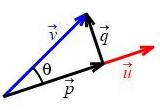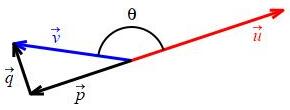5. Vectors
d. Dot Product
Recall the vector projections:


6. Scalar Projections
It is sometimes also useful to define scalar projections (also called components) of \(\vec v\) parallel and perpendicular to \(\vec u\). These are the lengths of the vector projections with the exception that for an obtuse angle the parallel component is the negative of the length so that the sign of the component tells whether the projection is in the same or opposite direction as \(\vec u\). Thus:
The component or scalar projection of the vector \(\vec v\) parallel to the direction of \(\vec u\) is denoted by \(\text{comp}_{\vec u}\vec v\) while the component or scalar projection of the vector \(\vec v\) perpendicular to the direction of \(\vec u\) is denoted by \(\text{comp}_{\perp\vec u}\vec v\). \[\begin{aligned} \text{comp}_{\vec u}\vec v &=\begin{cases} |\text{proj}_{\vec u}\vec v|&\text{if } \theta \text{ is acute} \\ -|\text{proj}_{\vec u}\vec v|&\text{if } \theta \text{ is obtuse} \qquad \text{(*)} \end{cases} \\ \text{comp}_{\perp\vec u}\vec v &=|\text{proj}_{\perp\vec u}\vec v| \end{aligned}\]
Again we would like to have computational fomulas for the components.
The component or scalar projection of \(\vec v\) parallel to \(\vec u\) is \[ \text{comp}_{\vec u}\vec v =|\vec v|\cos\theta =\dfrac{\vec v\cdot\vec u}{|\vec u|} \] The component or scalar projection of \(\vec v\) perpenducular to \(\vec u\) is \[ \text{comp}_{\perp\vec u}\vec v =|\vec v|\sin\theta =\sqrt{|\vec v|^2-\left(\text{comp}_{\vec u}\vec v\right)^2} \]


From the diagram, we have: \[ \cos\theta =\begin{cases} \dfrac{|\text{proj}_{\vec u}\vec v|}{|\vec v|}&\text{if } \theta \text{ is acute} \\ -\,\dfrac{|\text{proj}_{\vec u}\vec v|}{|\vec v|}&\text{if } \theta \text{ is obtuse} \end{cases} \qquad \text{and} \qquad \sin\theta=\dfrac{|\text{proj}_{\perp\vec u}\vec v|}{|\vec v|} \] since in the obtuse case the \(\cos\theta\) needs to be negative. Solving for the magnitudes of the projections, we have: \[ |\text{proj}_{\vec u}\vec v| =\begin{cases} |\vec v|\cos\theta&\text{if } \theta \text{ is acute} \\ -|\vec v|\cos\theta&\text{if } \theta \text{ is obtuse} \end{cases} \qquad \text{and} \qquad |\text{proj}_{\perp\vec u}\vec v|=|\vec v|\sin\theta \] Combining this with the definition (*) gives: \[ \text{comp}_{\vec u}\vec v=|\vec v|\cos\theta \qquad \text{and} \qquad \text{comp}_{\perp\vec u}\vec v=|\vec v|\sin\theta \] Notice that, in the obtuse case, the minus signs cancelled.
For the parallel component, we use the identity \(\cos\theta=\dfrac{\vec v\cdot\vec u}{|\vec v|\,|\vec u|}\) to get: \[ \text{comp}_{\vec u}\vec v=\dfrac{\vec v\cdot\vec u}{|\vec u|} \]
For the perpendicular component, we use the Pythagorean identity in the diagram above to get: \[ \text{comp}_{\perp\vec u}\vec v =\sqrt{|\vec v|^2-\left(\text{comp}_{\vec u}\vec v\right)^2} \]
Find the components of the vector \(\vec w=\left\langle -3,11\right\rangle\) parallel and perpendicular to the vector \(\vec v=\left\langle 1,3\right\rangle\). Is the angle between \(\vec v\) and \(\vec w\) acute or obtuse?
The parallel component is: \[\begin{aligned} \text{comp}_{\vec v}\vec w &=\dfrac{\vec w\cdot\vec v}{|\vec v|} =\dfrac{\left\langle -3,11\right\rangle\cdot\left\langle 1,3\right\rangle} {|\left\langle 1,3\right\rangle|} \\ &=\dfrac{30}{\sqrt{10}}=3\sqrt{10} \end{aligned}\] And the perpendicular component is: \[\begin{aligned} \text{comp}_{\perp\vec v}\vec w &=\sqrt{|\vec w|^2-\left(\text{comp}_{\vec v}\vec w\right)^2} \\ &=\sqrt{9+121-90}=\sqrt{40}=2\sqrt{10} \end{aligned}\] Since \(\text{comp}_{\vec v}\vec w=3\sqrt{10} \gt 0\), the angle is acute.
We check. From a example on the previous page, we have \[ \text{proj}_{\vec v}\vec w=\left\langle 3,9\right\rangle \qquad \text{and} \qquad \text{proj}_{\perp\vec v}\vec w=\left\langle -6,2\right\rangle \] So the components are: \[\begin{aligned} \text{comp}_{\vec v}\vec w&=\pm|\text{proj}_{\vec v}\vec w| \\ &=\pm\sqrt{9+81}=\pm\sqrt{90}=3\sqrt{10} \end{aligned}\] (We need the plus sign since the angle is acute.) \[\begin{aligned} \text{comp}_{\perp\vec v}\vec w&=|\text{proj}_{\perp\vec v}\vec w| \\ &=\sqrt{36+4}=\sqrt{40}=2\sqrt{10} \end{aligned}\] Also notice \(|\vec w|=\sqrt{3^2+11^2}=\sqrt{130}\) and \[ \sqrt{(\text{comp}_{\vec v}\vec w)^2+(\text{comp}_{\perp\vec v}\vec w)^2} =\sqrt{\sqrt{90}^{\,2}+\sqrt{40}^{\,2}}=\sqrt{130} \]
Computing the length of the perpendicular projection is another good way to compute the perpendicular component. However, computing the length of the parallel projection will not tell you if the parallel component is positive or negative. For that, you must compute the dot product or use geometry to see if the angle is acute or obtuse.
Find the components of the vector \(\vec a=\left\langle 7,-4\right\rangle\) parallel and perpendicular to the vector \(\vec b=\left\langle -1,2\right\rangle\). Is the angle between \(\vec b\) and \(\vec a\) acute or obtuse?
\(\text{comp}_{\vec b}\vec a=-3\sqrt{5}\)
\(\text{comp}_{\perp\vec b}\vec a=2\sqrt{5}\)
The angle is obtuse.
The parallel component is: \[\begin{aligned} \text{comp}_{\vec b}\vec a &=\dfrac{\vec a\cdot\vec b}{|\vec b|} =\dfrac{\left\langle 7,-4\right\rangle\cdot\left\langle -1,2\right\rangle} {|\left\langle -1,2\right\rangle|} \\ &=\dfrac{-15}{\sqrt{5}}=-3\sqrt{5} \end{aligned}\] And the perpendicular component is: \[\begin{aligned} \text{comp}_{\perp\vec b}\vec a &=\sqrt{|\vec a|^2-\left(\text{comp}_{\vec b}\vec a\right)^2} \\ &=\sqrt{49+16-45}=\sqrt{20}=2\sqrt{5} \end{aligned}\] Since \(\text{comp}_{\vec b}\vec a=-3\sqrt{5} \lt 0\), the angle is obtuse.
We check. From the exercise on the previous page, we have \[ \text{proj}_{\vec b}\vec a=\left\langle 3,-6\right\rangle \qquad \text{and} \qquad \text{proj}_{\perp\vec b}\vec a=\left\langle 4,2\right\rangle \] So the components are: \[\begin{aligned} \text{comp}_{\vec b}\vec a&=\pm|\text{proj}_{\vec b}\vec a| \\ &=\pm\sqrt{9+36}=\pm\sqrt{45}=-3\sqrt{5} \end{aligned}\] (We need the minus sign since the angle is obtuse.) \[\begin{aligned} \text{comp}_{\perp\vec b}\vec a&=|\text{proj}_{\perp\vec b}\vec a| \\ &=\sqrt{16+4}=\sqrt{20}=2\sqrt{5} \end{aligned}\]
Heading
Placeholder text: Lorem ipsum Lorem ipsum Lorem ipsum Lorem ipsum Lorem ipsum Lorem ipsum Lorem ipsum Lorem ipsum Lorem ipsum Lorem ipsum Lorem ipsum Lorem ipsum Lorem ipsum Lorem ipsum Lorem ipsum Lorem ipsum Lorem ipsum Lorem ipsum Lorem ipsum Lorem ipsum Lorem ipsum Lorem ipsum Lorem ipsum Lorem ipsum Lorem ipsum